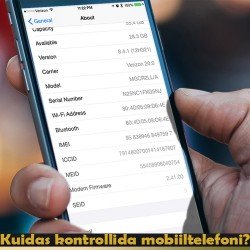How to check an Apple iMac?
- Version: V25051801
- Article helped to write: Antud artikkel on tõlgitud tehisintellekti abil.
Attention! Due to the increasing number of Apple devices being locked after they have already been accepted, a new mandatory rule is being introduced regarding the acceptance of all Apple devices. We strongly recommend that all employees familiarize themselves with this rule and strictly apply it to all Apple devices without exception.
You can read the full rule in the article: How to accept and check Apple devices?
The iMac is an all-in-one desktop computer from Apple that runs macOS. Like all Apple devices, the iMac is tightly integrated with iCloud and the Activation Lock feature. This makes it mandatory to check that the Apple ID is signed out and Find My Mac is turned off before accepting the device. It’s also important to verify the authenticity, physical condition, completeness, and full functionality of all components (display, camera, microphone, ports, etc.).
How to verify the authenticity of an iMac?
- Serial number: Find the serial number via the Apple menu → “About This Mac” or underneath the iMac stand. Compare it with the box (if available). Check authenticity on the official site: checkcoverage.apple.com.
- macOS condition: The iMac must boot into the original macOS without errors. Ensure there are no third-party modifications or attempts to install non-Apple operating systems.
- Interface and software: Make sure the iMac is not using custom bootloaders or third-party BIOS. Check access to App Store, system settings, and iCloud.
- Build quality: Inspect the case for cracks, chips, or tampering signs. Check the stand — it must be sturdy and not loose. The glass and screen must be clean and scratch-free.
- Ports and connections: Test all available ports: USB, USB-C, Thunderbolt, Ethernet, SD card reader (if present). Ports must be intact, without damage or signs of corrosion.
- Power: Connect the original power cable and make sure the device powers on reliably. No battery check is needed, as iMacs do not contain internal batteries.
-
Bootloader and locks:
Ensure there is no
firmware (EFI) password
set. Devices with such a lock
are not accepted.
For Intel-based iMacs: Restart the iMac and hold ⌘ + R. If a password is requested before entering recovery mode, the device is locked.
For Apple Silicon (M1/M2/M3 and newer): Power off the iMac completely, then press and hold the power button until the Startup Options screen appears.
If the Startup Options menu appears — the device is not locked. If a lock icon or password request appears — the iMac has firmware lock.
Devices that must not be accepted
- Devices with active Activation Lock / Find My Mac
- Devices with an enabled firmware password (EFI / firmware lock)
- Devices without an operating system installed
- iMacs with critical physical defects (screen cracks, casing deformation, swollen display, broken stand)
- Devices that cannot boot into macOS or Recovery mode
How to inspect an iMac before acceptance?
- Power-on and system boot: Ensure the iMac powers on reliably, does not enter boot loops, and successfully loads the desktop without errors.
-
Display:
- Brightness adjusts smoothly, backlight is even.
- No spots, lines, dead pixels, or flickering.
- Check color accuracy: white, black, red, green, blue.
-
Sound:
- Play video or music — speakers should sound clear, without crackling or distortion.
- Check left and right channel balance.
- If available, connect headphones or a Bluetooth headset — audio must function properly.
-
Microphone and camera:
- Open the “Photo Booth” or FaceTime app — verify that the camera image is clear.
- Use the “Voice Memos” app to record — ensure the microphone captures sound cleanly.
-
Wi-Fi and Bluetooth:
- Wi-Fi should detect and connect to networks without issues.
- Bluetooth should find and connect to devices (e.g., mouse, headphones).
-
Ports and interfaces:
- Test all ports: USB, USB-C, HDMI, Ethernet, card reader (if present).
- There should be no looseness, damage, or corrosion on connectors.
-
Peripheral functionality (if included):
- Test the keyboard and mouse if they are part of the set.
- Keys must respond properly and consistently.
-
Physical condition:
- Inspect the body for chips, cracks, bulges, or signs of tampering.
- The stand must be intact and stable; the screen should not tilt or shift on its own.
How to Unlink an iMac from the Previous Owner
Before accepting an iMac, you must complete all steps to unlink the device from the Apple ID and remove it from “Find My”. Skipping any step may result in the device being locked and unusable.
- 1. Ensure the iMac powers on and boots to the desktop.
-
2. Check Apple ID connection on the iMac itself:
- Open the menu → “System Settings” → “Apple ID” (or user name).
- Verify that the client is signed in and able to sign out.
- Click “Sign Out”, enter the Apple ID password, and confirm the logout.
-
3. Ensure that “Find My Mac” is turned off:
- Go to “System Settings” → “Apple ID” → “iCloud”.
- Confirm that “Find My Mac” is disabled.
-
4. Confirm that the iMac is removed from the client’s “Find My” app on their phone:
- Ask the client to open the “Find My” app on their iPhone or iPad.
- Go to the “Devices” tab.
- Verify that this iMac is not listed.
- If it is listed — select it and tap “Remove This Device”.
-
5. Create a new administrator account:
- Go to “System Settings” → “Users & Groups”.
- Click the “+” button and choose Administrator as the account type.
- Username:
adminorluutar. - Password: 12345678 — required.
-
6.
If accepted as a pawn:
- The old user account does not need to be deleted.
- Ensure a new admin account with password 12345678 has been created.
-
7.
If the iMac is being purchased:
- The old user account must be deleted.
- Only the new local administrator account with password 12345678 should remain.
Finalize the Agreement
You can now proceed to create a contract for the iMac. Please note that the product name must follow the exact format: "Desktop Computer Apple iMac Model". Do not use abbreviations like "Mac", "mäkk", "arvuti", or other generic terms — only use the full model name, such as: Apple iMac 24" M1 2021.
Selling or Listing an iMac for Sale
Before listing an iMac for sale, you must verify the following points:
- The device is not linked to an Apple ID, and Find My Mac is disabled.
- The user has logged out of all iCloud and Apple ID accounts on the iMac.
- All previous user accounts have been deleted.
- A new local administrator account has been created with the default username and password 12345678.
- Upon startup, the iMac does not ask for Apple ID and does not prompt for activation.
- The device boots to the desktop without errors or warnings.
- The screen, ports, speakers, microphone, camera, Wi-Fi, Bluetooth, keyboard, and mouse (if included) have all been tested and are working properly.
Important: If any previous user accounts remain on the device or if the system prompts for Apple ID login, the iMac cannot be sold.
How to Factory Reset an iMac
- Ensure that you have logged out of the Apple ID and disabled Find My Mac.
- Go to menu → System Settings → General → Transfer or Reset.
- Select Erase All Content and Settings.
- Confirm the action, enter the admin password, and follow the on-screen instructions.
- After reset is complete, the iMac will restart and display the Hello screen — the device is ready for a new owner.
Warning: Do not use macOS Recovery mode for a full system reinstall on devices running macOS older than 3 years if they haven’t been updated. Apple removes outdated macOS images from its servers, and attempting a reinstall may render the device unusable (software brick).
Recommended: If the system hasn’t been updated for a long time, sign in and update macOS to the latest version first, and only then perform the reset through the system interface, not through Internet Recovery.
















